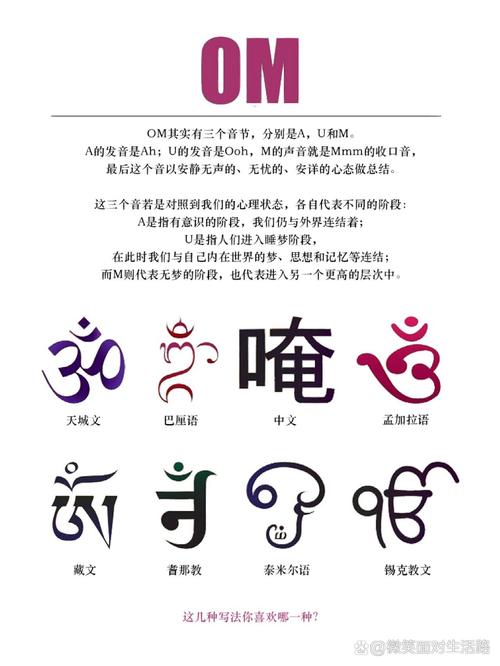Om Symbol Text: A Comprehensive Guide
The Om symbol, often represented as “AUM,” is a sacred sound and symbol in Hinduism, Buddhism, and Jainism. It holds immense significance and is considered to be the primordial sound from which the universe emerged. In this article, we will delve into the various dimensions of the Om symbol, exploring its origins, meanings, and its role in different cultures and religions.
Origins of the Om Symbol
The Om symbol has its roots in ancient Indian texts and scriptures. It is believed to have originated from the Vedic period, around 1500-500 BCE. The symbol is mentioned in the Rigveda, one of the oldest sacred texts in Hinduism. The Rigveda describes Om as the source of all creation and the ultimate reality.

Archaeological evidence suggests that the Om symbol was used in ancient India as a sacred mantra and symbol of divine power. It was often inscribed on artifacts, temples, and monuments, indicating its importance in the religious and cultural practices of the time.
Meanings of the Om Symbol
The Om symbol is a complex and multifaceted symbol with various meanings. Here are some of the key interpretations:
-
Primordial Sound: Om is considered to be the primordial sound from which the universe emerged. It represents the infinite and eternal nature of the universe.
-
Divine Presence: Om is often associated with the presence of the divine in the universe. It is believed to be the sound of the divine and is used in meditation and prayer to invoke the divine presence.

-
Union of Opposites: Om represents the union of the masculine and feminine energies in the universe. It symbolizes the balance and harmony between the two.
-
Creation and Destruction: Om is associated with the cycles of creation and destruction. It represents the eternal cycle of birth, death, and rebirth.
Role in Different Cultures and Religions
The Om symbol is not limited to Hinduism; it holds significance in other cultures and religions as well.
Hinduism
In Hinduism, the Om symbol is considered to be the most sacred sound and is used in various religious practices. It is often chanted as a mantra during meditation, prayer, and rituals. The symbol is also found in many Hindu temples and sacred texts.
Buddhism
In Buddhism, the Om symbol is associated with the Buddha and is used in meditation and prayer. It is believed to have the power to purify the mind and invoke the presence of the Buddha. The symbol is often found in Buddhist temples and artworks.
Jainism
In Jainism, the Om symbol is considered to be a sacred sound and is used in meditation and prayer. It is believed to have the power to purify the soul and invoke the presence of the divine. The symbol is often found in Jain temples and sacred texts.
Other Religions and Cultures
The Om symbol has also gained popularity in other religions and cultures, such as Sikhism, Christianity, and New Age spirituality. It is often used as a symbol of peace, unity, and spiritual awakening.
Om Symbol in Modern Times
In modern times, the Om symbol has become a popular symbol of spirituality and mindfulness. It is often used in yoga studios, meditation centers, and wellness retreats. The symbol is also used in jewelry, artwork, and fashion, symbolizing the pursuit of inner peace and spiritual growth.
Conclusion
The Om symbol is a powerful and multifaceted symbol with deep roots in ancient Indian culture and spirituality. Its significance extends beyond Hinduism, influencing various cultures and religions around the world. Whether used in meditation, prayer, or as a symbol of spiritual awakening, the Om symbol continues to hold a special place in the hearts and minds of many.
| Origin | Meaning | Role in Different Cultures and Religions |
|---|---|---|
| India, Vedic period | Primordial sound, divine presence, union of opposites, creation and destruction | Hinduism, Buddhism, Jainism, other religions and cultures |




